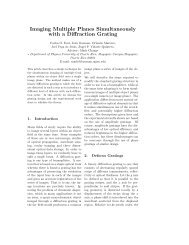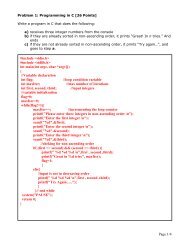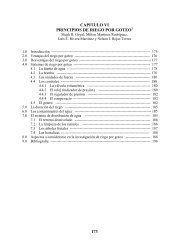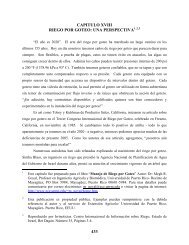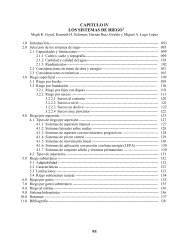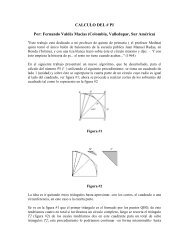The class JOptionPane (javax.swing) allows you to display a dialog ...
The class JOptionPane (javax.swing) allows you to display a dialog ...
The class JOptionPane (javax.swing) allows you to display a dialog ...
Create successful ePaper yourself
Turn your PDF publications into a flip-book with our unique Google optimized e-Paper software.
Fig. 2.8: Addition.java An addition program<br />
import <strong>javax</strong>.<strong>swing</strong>.<strong>JOptionPane</strong>;<br />
public <strong>class</strong> Addition {<br />
public static void main( String args[] )<br />
{<br />
String firstNumber, secondNumber;<br />
int number1, number2, sum;<br />
// read in first number from user as a string<br />
firstNumber = <strong>JOptionPane</strong>.showInputDialog( "Enter first integer" );<br />
// read in second number from user as a string<br />
secondNumber = <strong>JOptionPane</strong>.showInputDialog( "Enter second integer" );<br />
// convert numbers from type String <strong>to</strong> type int<br />
number1 = Integer.parseInt( firstNumber );<br />
number2 = Integer.parseInt( secondNumber );<br />
sum = number1 + number2;<br />
// <strong>display</strong> the results<br />
<strong>JOptionPane</strong>.showMessageDialog( null, "<strong>The</strong> sum is " + sum, "Results", <strong>JOptionPane</strong>.PLAIN_MESSAGE );<br />
System.exit( 0 ); // terminate the program<br />
}<br />
}<br />
// Fig. 3.10: WelcomeLines.java Displaying text and lines<br />
import <strong>javax</strong>.<strong>swing</strong>.JApplet;<br />
import java.awt.Graphics;<br />
public <strong>class</strong> WelcomeLines extends JApplet {<br />
public void paint( Graphics g )<br />
{<br />
g.drawLine( 15, 10, 210, 10 );<br />
g.drawLine( 15, 30, 210, 30 );<br />
g.drawString( "Welcome <strong>to</strong> Java Programming!", 25, 25 );<br />
}<br />
}<br />
<strong>The</strong> <strong>class</strong> <strong>JOptionPane</strong> (<strong>javax</strong>.<strong>swing</strong>) <strong>allows</strong> <strong>you</strong> <strong>to</strong> <strong>display</strong> a <strong>dialog</strong> box containing info.<br />
• showMessageDialog(), showInputDialog()<br />
Graphics object:<br />
• drawString(), drawLine(), drawOval(), drawRect()
Fig. 3.12: AdditionApplet.java Adding two floating-point numbers<br />
import java.awt.Graphics;<br />
import <strong>javax</strong>.<strong>swing</strong>.*;<br />
public <strong>class</strong> AdditionApplet extends JApplet {<br />
double sum;<br />
public void init()<br />
{<br />
String firstNumber, secondNumber;<br />
double number1, number2;<br />
}<br />
// read in first number from user<br />
firstNumber = <strong>JOptionPane</strong>.showInputDialog( "Enter first floating-point value" );<br />
// read in second number from user<br />
secondNumber = <strong>JOptionPane</strong>.showInputDialog( "Enter second floating-point value" );<br />
// convert numbers from type String <strong>to</strong> type double<br />
number1 = Double.parseDouble( firstNumber );<br />
number2 = Double.parseDouble( secondNumber );<br />
sum = number1 + number2;<br />
public void paint( Graphics g )<br />
{<br />
// draw the results with g.drawString<br />
g.drawRect( 15, 10, 270, 20 );<br />
g.drawString( "<strong>The</strong> sum is " + sum, 25, 25 );<br />
}<br />
}
Fig. 5.6: Interest.java Calculating compound interest<br />
import java.text.DecimalFormat;<br />
import <strong>javax</strong>.<strong>swing</strong>.<strong>JOptionPane</strong>;<br />
import <strong>javax</strong>.<strong>swing</strong>.JTextArea;<br />
public <strong>class</strong> Interest {<br />
public static void main( String args[] )<br />
{<br />
double amount, principal = 1000.0, rate = .05;<br />
DecimalFormat precisionTwo = new DecimalFormat( "0.00" );<br />
JTextArea outputTextArea = new JTextArea( 11, 20 );<br />
outputTextArea.append( "Year\tAmount on deposit\n" );<br />
for ( int year = 1; year
Fig. 5.7: SwitchTest.java Drawing shapes<br />
import java.awt.Graphics;<br />
import <strong>javax</strong>.<strong>swing</strong>.*;<br />
public <strong>class</strong> SwitchTest extends JApplet {<br />
int choice;<br />
public void init()<br />
{<br />
String input;<br />
input = <strong>JOptionPane</strong>.showInputDialog(<br />
"Enter 1 <strong>to</strong> draw lines\n" +<br />
"Enter 2 <strong>to</strong> draw rectangles\n" +<br />
"Enter 3 <strong>to</strong> draw ovals\n" );<br />
choice = Integer.parseInt( input );<br />
}<br />
public void paint( Graphics g )<br />
{<br />
for ( int i = 0; i < 10; i++ ) {<br />
switch( choice ) {<br />
case 1:<br />
g.drawLine( 10, 10, 250, 10 + i * 10 );<br />
break;<br />
case 2:<br />
g.drawRect( 10 + i * 10, 10 + i * 10, 50 + i * 10, 50 + i * 10 );<br />
break;<br />
case 3:<br />
g.drawOval( 10 + i * 10, 10 + i * 10, 50 + i * 10, 50 + i * 10 );<br />
break;<br />
default:<br />
<strong>JOptionPane</strong>.showMessageDialog( null, "Invalid value entered" );<br />
} // end switch<br />
} // end for<br />
} // end paint()<br />
} // end <strong>class</strong> SwitchTest
Fig. 5.19: LogicalOpera<strong>to</strong>rs.java Demonstrating the logical opera<strong>to</strong>rs<br />
import <strong>javax</strong>.<strong>swing</strong>.*;<br />
public <strong>class</strong> LogicalOpera<strong>to</strong>rs {<br />
public static void main( String args[] )<br />
{<br />
JTextArea outputArea = new JTextArea( 17, 20 );<br />
JScrollPane scroller = new JScrollPane( outputArea );<br />
String output = "";<br />
output += "Logical AND (&&)" + "\nfalse && false: " + ( false && false ) + "\nfalse && true: "<br />
+ ( false && true ) + "\ntrue && false: " + ( true && false ) + "\ntrue && true: " + ( true && true );<br />
output += "\n\nLogical OR (||)" +<br />
"\nfalse || false: " + ( false || false ) +<br />
"\nfalse || true: " + ( false || true ) +<br />
"\ntrue || false: " + ( true || false ) +<br />
"\ntrue || true: " + ( true || true );<br />
output += "\n\nBoolean logical AND (&)" +<br />
"\nfalse & false: " + ( false & false ) +<br />
"\nfalse & true: " + ( false & true ) +<br />
"\ntrue & false: " + ( true & false ) +<br />
"\ntrue & true: " + ( true & true );<br />
output += "\n\nBoolean logical inclusive OR (|)" +<br />
"\nfalse | false: " + ( false | false ) +<br />
"\nfalse | true: " + ( false | true ) +<br />
"\ntrue | false: " + ( true | false ) +<br />
"\ntrue | true: " + ( true | true );<br />
output += "\n\nBoolean logical exclusive OR (^)" +<br />
"\nfalse ^ false: " + ( false ^ false ) +<br />
"\nfalse ^ true: " + ( false ^ true ) +<br />
"\ntrue ^ false: " + ( true ^ false ) +<br />
"\ntrue ^ true: " + ( true ^ true );<br />
output += "\n\nLogical NOT (!)" +<br />
"\n!false: " + ( !false ) +<br />
"\n!true: " + ( !true );<br />
outputArea.setText( output );<br />
<strong>JOptionPane</strong>.showMessageDialog( null, scroller,<br />
"Truth Tables", <strong>JOptionPane</strong>.INFORMATION_MESSAGE );<br />
System.exit( 0 );<br />
}<br />
}<br />
Fig 5-19: Class JScrollPane (<strong>javax</strong>.<strong>swing</strong>) provides a GUI component with scrolling<br />
functionality. It is initialized with the GUI component for which it will provide scrolling.<br />
JScrollPane scroller = new JSP( outputArea);
Fig. 6.3: SquareInt.java A programmer-defined square method<br />
import java.awt.Container;<br />
import <strong>javax</strong>.<strong>swing</strong>.*;<br />
public <strong>class</strong> SquareInt extends JApplet {<br />
public void init()<br />
{<br />
String output = "";<br />
JTextArea outputArea = new JTextArea( 10, 20 );<br />
// get the applet's GUI component <strong>display</strong> area<br />
Container c = getContentPane();<br />
// attach outputArea <strong>to</strong> Container c<br />
c.add( outputArea );<br />
int result;<br />
for ( int x = 1; x
Fig 6.9: Container and FlowLa<strong>you</strong>t are imported from java.awt. <strong>The</strong> java.awt.event contains<br />
many data types that enable a program <strong>to</strong> process a user’s interactions with a program<br />
(ActionListener, ActionEvent). JApplet, JLabel, JLextField and JBut<strong>to</strong>n are imported from<br />
<strong>javax</strong>.<strong>swing</strong>.<br />
A JLabel contains a string of chars <strong>to</strong> <strong>display</strong> on the screen. It normally indicates the purpose of<br />
another gui element on the screen.<br />
JTextFields are used <strong>to</strong> get a single line of info from the user at the keyboard or <strong>to</strong> <strong>display</strong> info<br />
on the screen.<br />
• setEditable(): with argument false indicates that it is not editable (gray background).<br />
Method init() creates the gui components and attaches them <strong>to</strong> the user interface.<br />
c.setLa<strong>you</strong>t (new FlowLa<strong>you</strong>t() );<br />
This method defines the la<strong>you</strong>t manager for the applet’s user interface. La<strong>you</strong>t managers are<br />
provided <strong>to</strong> arrange components on a Container for presentation purposes. <strong>The</strong>y determine the<br />
position and size of every component attached.<br />
FlowLa<strong>you</strong>t is the most basic manager. GUI components are placed from left <strong>to</strong> right in the<br />
order in which they are attached <strong>to</strong> the Container with the method add().<br />
Each Container can have only one la<strong>you</strong>t manager at a time. Separate Containers in the same<br />
program can have different managers.<br />
<strong>The</strong> interface ActionListener specifies that the <strong>class</strong> must define the method:<br />
public void actionPerformed(ActionEvent e)<br />
This method is used <strong>to</strong> process a user’s interaction with the JBut<strong>to</strong>n. When the user presses the<br />
but<strong>to</strong>n, this method will be called au<strong>to</strong>matically in response <strong>to</strong> the user interaction (event). This<br />
process is called event handling. <strong>The</strong> handler is the actionPerfomed() method.<br />
roll.addActionListener( this );<br />
<strong>The</strong> above method registers the applet (this) as the listener for events from the JBut<strong>to</strong>n roll.<br />
When a GUI event occurs in a program, Java creates an object containing info about the event<br />
that occurred and au<strong>to</strong>matically calls an appropriate event handling method.<br />
Before any event can be processed, each GUI component must know which object in the<br />
program defines the event handling method that will be called when the event occurs.
To respond <strong>to</strong> an action event, we must define a <strong>class</strong> that implements ActionListener (that<br />
requires that the <strong>class</strong> also define method actionPerformed() ) and we must register the event<br />
handler.<br />
actionPerformed() receives one argument – an ActionEvent – which contains info about the<br />
action that has occurred.
Fig. 6.9: Craps.java Craps<br />
import java.awt.*; import java.awt.event.*; import <strong>javax</strong>.<strong>swing</strong>.*;<br />
public <strong>class</strong> Craps extends JApplet implements ActionListener {<br />
final int WON = 0, LOST = 1, CONTINUE = 2; // const varis for status of game<br />
boolean firstRoll = true; // true if first roll<br />
int sumOfDice = 0; // sum of the dice<br />
int myPoint = 0; // point if no win/loss on first roll<br />
int gameStatus = CONTINUE; // game not over yet<br />
JLabel die1Label, die2Label, sumLabel, pointLabel;<br />
JTextField firstDie, secondDie, sum, point;<br />
JBut<strong>to</strong>n roll;<br />
public void init() { // setup graphical user interface components<br />
Container c = getContentPane();<br />
c.setLa<strong>you</strong>t( new FlowLa<strong>you</strong>t() );<br />
die1Label = new JLabel( "Die 1" );<br />
c.add( die1Label );<br />
firstDie = new JTextField( 10 );<br />
firstDie.setEditable( false );<br />
c.add( firstDie );<br />
die2Label = new JLabel( "Die 2" );<br />
c.add( die2Label );<br />
secondDie = new JTextField( 10 );<br />
secondDie.setEditable( false );<br />
c.add( secondDie );<br />
sumLabel = new JLabel( "Sum is" );<br />
c.add( sumLabel );<br />
sum = new JTextField( 10 );<br />
sum.setEditable( false );<br />
c.add( sum );<br />
pointLabel = new JLabel( "Point is" );<br />
c.add( pointLabel );<br />
point = new JTextField( 10 );<br />
point.setEditable( false );<br />
c.add( point );<br />
roll = new JBut<strong>to</strong>n( "Roll Dice" );<br />
roll.addActionListener( this );<br />
c.add( roll );<br />
}<br />
public void actionPerformed( ActionEvent e ) { // call method play when but<strong>to</strong>n is pressed<br />
play();<br />
}
public void play() { // process one roll of the dice<br />
if ( firstRoll ) { // first roll of the dice<br />
sumOfDice = rollDice();<br />
switch ( sumOfDice ) {<br />
case 7: case 11: // win on first roll<br />
gameStatus = WON;<br />
point.setText( "" ); // clear point text field<br />
break;<br />
case 2: case 3: case 12: // lose on first roll<br />
gameStatus = LOST;<br />
point.setText( "" ); // clear point text field<br />
break;<br />
default: // remember point<br />
gameStatus = CONTINUE;<br />
myPoint = sumOfDice;<br />
point.setText( Integer.<strong>to</strong>String( myPoint ) );<br />
firstRoll = false;<br />
break;<br />
}<br />
}<br />
else {<br />
sumOfDice = rollDice();<br />
if ( sumOfDice == myPoint ) // win by making point<br />
gameStatus = WON;<br />
else<br />
if ( sumOfDice == 7 ) // lose by rolling 7<br />
gameStatus = LOST;<br />
}<br />
if ( gameStatus == CONTINUE )<br />
showStatus( "Roll again." );<br />
else {<br />
if ( gameStatus == WON )<br />
showStatus( "Player wins. " + "Click Roll Dice <strong>to</strong> play again." );<br />
else<br />
showStatus( "Player loses. " + "Click Roll Dice <strong>to</strong> play again." );<br />
firstRoll = true;<br />
}<br />
}<br />
public int rollDice() { // roll the dice<br />
int die1, die2, workSum;<br />
die1 = 1 + ( int ) ( Math.random() * 6 );<br />
die2 = 1 + ( int ) ( Math.random() * 6 );<br />
workSum = die1 + die2;<br />
firstDie.setText( Integer.<strong>to</strong>String( die1 ) );<br />
secondDie.setText( Integer.<strong>to</strong>String( die2 ) );<br />
sum.setText( Integer.<strong>to</strong>String( workSum ) );<br />
return workSum;<br />
}<br />
}
Fig. 6.13: FibonacciTest.java Recursive fibonacci method<br />
public <strong>class</strong> FibonacciTest extends Japplet implements ActionListener {<br />
JLabel numLabel, resultLabel;<br />
JTextField num, result;<br />
public void init()<br />
{<br />
Container c = getContentPane();<br />
c.setLa<strong>you</strong>t( new FlowLa<strong>you</strong>t() );<br />
numLabel = new JLabel( "Enter an integer and press Enter" );<br />
c.add( numLabel );<br />
num = new JTextField( 10 );<br />
num.addActionListener( this );<br />
c.add( num );<br />
resultLabel = new JLabel( "Fibonacci value is" );<br />
c.add( resultLabel );<br />
result = new JTextField( 15 );<br />
result.setEditable( false );<br />
c.add( result );<br />
}<br />
public void actionPerformed( ActionEvent e )<br />
{<br />
long number, fibonacciValue;<br />
number = Long.parseLong( num.getText() );<br />
showStatus( "Calculating ..." );<br />
fibonacciValue = fibonacci( number );<br />
showStatus( "Done." );<br />
result.setText( Long.<strong>to</strong>String( fibonacciValue ) );<br />
}<br />
public long fibonacci( long n ) // Recursive definition of method fibonacci<br />
{<br />
if ( n == 0 || n == 1 ) // base case<br />
return n;<br />
else<br />
return fibonacci( n - 1 ) + fibonacci( n - 2 );<br />
}<br />
}<br />
Fig 6-13: In this example, the user presses the Enter key while typing in the JTextField num <strong>to</strong><br />
generate the action event.<br />
Au<strong>to</strong>matically, a message is sent <strong>to</strong> the applet indication that the user interacted with one of the<br />
program’s GUI components.
<strong>The</strong> message e.getActionCommand(), when executed inside the handler, returns the string the<br />
user typed in the JTextField before pressing the Enter key.
Fig. 8.5: TimeTest.java Demonstrating the Time3 <strong>class</strong> set and get methods<br />
import java.awt.*;<br />
import java.awt.event.*;<br />
import <strong>javax</strong>.<strong>swing</strong>.*;<br />
import com.deitel.jhtp3.ch08.Time3;<br />
public <strong>class</strong> TimeTest extends Japplet implements ActionListener {<br />
private Time3 t;<br />
private JLabel hourLabel, minuteLabel, secondLabel;<br />
private JTextField hourField, minuteField, secondField, <strong>display</strong>;<br />
private JBut<strong>to</strong>n tickBut<strong>to</strong>n;<br />
public void init() {<br />
t = new Time3();<br />
Container c = getContentPane();<br />
c.setLa<strong>you</strong>t( new FlowLa<strong>you</strong>t() );<br />
hourLabel = new JLabel( "Set Hour" );<br />
hourField = new JTextField( 10 );<br />
hourField.addActionListener( this );<br />
c.add( hourLabel );<br />
c.add( hourField );<br />
minuteLabel = new JLabel( "Set minute" );<br />
minuteField = new JTextField( 10 );<br />
minuteField.addActionListener( this );<br />
c.add( minuteLabel );<br />
c.add( minuteField );<br />
secondLabel = new JLabel( "Set Second" );<br />
secondField = new JTextField( 10 );<br />
secondField.addActionListener( this );<br />
c.add( secondLabel );<br />
c.add( secondField );<br />
<strong>display</strong> = new JTextField( 30 );<br />
<strong>display</strong>.setEditable( false );<br />
c.add( <strong>display</strong> );<br />
tickBut<strong>to</strong>n = new JBut<strong>to</strong>n( "Add 1 <strong>to</strong> Second" );<br />
tickBut<strong>to</strong>n.addActionListener( this );<br />
c.add( tickBut<strong>to</strong>n );<br />
updateDisplay();<br />
}
public void actionPerformed( ActionEvent e )<br />
{<br />
if ( e.getSource() == tickBut<strong>to</strong>n )<br />
tick();<br />
else if ( e.getSource() == hourField ) {<br />
t.setHour( Integer.parseInt( e.getActionCommand() ) );<br />
hourField.setText( "" );<br />
}<br />
else if ( e.getSource() == minuteField ) {<br />
t.setMinute( Integer.parseInt( e.getActionCommand() ) );<br />
minuteField.setText( "" );<br />
}<br />
else if ( e.getSource() == secondField ) {<br />
t.setSecond( Integer.parseInt( e.getActionCommand() ) );<br />
secondField.setText( "" );<br />
}<br />
updateDisplay();<br />
}<br />
public void updateDisplay()<br />
{<br />
<strong>display</strong>.setText( "Hour: " + t.getHour() +<br />
"; Minute: " + t.getMinute() +<br />
"; Second: " + t.getSecond() );<br />
showStatus( "Standard time is: " + t.<strong>to</strong>String() +<br />
"; Universal time is: " + t.<strong>to</strong>UniversalString() );<br />
}<br />
public void tick()<br />
{<br />
t.setSecond( ( t.getSecond() + 1 ) % 60 );<br />
}<br />
}<br />
}<br />
if ( t.getSecond() == 0 ) {<br />
t.setMinute( ( t.getMinute() + 1 ) % 60 );<br />
if ( t.getMinute() == 0 )<br />
t.setHour( ( t.getHour() + 1 ) % 24 );<br />
Fig 8-5: Several GUI components that are being handled with the same method. <strong>The</strong> handler<br />
uses e.getSource() <strong>to</strong> determine which component generated the event. <strong>The</strong> ActionEvent<br />
parameter that is supplied <strong>to</strong> the handler contains a refernce <strong>to</strong> the source.
Fig. 9.12: Time.java Time <strong>class</strong> definition<br />
import java.text.DecimalFormat; // used for number formatting<br />
public <strong>class</strong> Time extends Object {<br />
private int hour;<br />
private int minute;<br />
private int second;<br />
public Time() { setTime( 0, 0, 0 ); }<br />
public void setTime( int h, int m, int s ) {<br />
setHour( h ); setMinute( m); setSecond( s );<br />
}<br />
public void setHour( int h )<br />
{ hour = ( ( h >= 0 && h < 24 ) ? h : 0 ); }<br />
public void setMinute( int m )<br />
{ minute = ( ( m >= 0 && m < 60 ) ? m : 0 ); }<br />
public void setSecond( int s )<br />
{ second = ( ( s >= 0 && s < 60 ) ? s : 0 ); }<br />
public int getHour() { return hour; }<br />
public int getMinute() { return minute; }<br />
public int getSecond() { return second; }<br />
public String <strong>to</strong>String()<br />
{<br />
DecimalFormat twoDigits = new DecimalFormat( "00" );<br />
}<br />
}<br />
return ( ( getHour() == 12 || getHour() == 0 ) ?<br />
12 : getHour() % 12 ) + ":" +<br />
twoDigits.format( getMinute() ) + ":" +<br />
twoDigits.format( getSecond() ) +<br />
( getHour() < 12 ? " AM" : " PM" );<br />
// Fig. 9.12: TimeTestWindow.java Demonstrating the Time <strong>class</strong> set and get methods<br />
import java.awt.*;<br />
import java.awt.event.*;<br />
import <strong>javax</strong>.<strong>swing</strong>.*;<br />
public <strong>class</strong> TimeTestWindow extends JFrame {<br />
private Time t;<br />
private JLabel hourLabel, minuteLabel, secondLabel;<br />
private JTextField hourField, minuteField, secondField, <strong>display</strong>;<br />
private JBut<strong>to</strong>n exitBut<strong>to</strong>n;
public TimeTestWindow() {<br />
super( "Inner Class Demonstration" );<br />
t = new Time();<br />
Container c = getContentPane();<br />
// create an instance of the inner <strong>class</strong><br />
ActionEventHandler handler = new ActionEventHandler();<br />
c.setLa<strong>you</strong>t( new FlowLa<strong>you</strong>t() );<br />
hourLabel = new JLabel( "Set Hour" );<br />
hourField = new JTextField( 10 );<br />
hourField.addActionListener( handler );<br />
c.add( hourLabel );<br />
c.add( hourField );<br />
minuteLabel = new JLabel( "Set minute" );<br />
minuteField = new JTextField( 10 );<br />
minuteField.addActionListener( handler );<br />
c.add( minuteLabel );<br />
c.add( minuteField );<br />
secondLabel = new JLabel( "Set Second" );<br />
secondField = new JTextField( 10 );<br />
secondField.addActionListener( handler );<br />
c.add( secondLabel );<br />
c.add( secondField );<br />
<strong>display</strong> = new JTextField( 30 );<br />
<strong>display</strong>.setEditable( false );<br />
c.add( <strong>display</strong> );<br />
exitBut<strong>to</strong>n = new JBut<strong>to</strong>n( "Exit" );<br />
exitBut<strong>to</strong>n.addActionListener( handler );<br />
c.add( exitBut<strong>to</strong>n );<br />
}<br />
public void <strong>display</strong>Time() {<br />
<strong>display</strong>.setText( "<strong>The</strong> time is: " + t );<br />
}<br />
public static void main( String args[] ) {<br />
TimeTestWindow window = new TimeTestWindow();<br />
window.setSize( 400, 140 );<br />
window.show();<br />
}
INNER CLASS DEFINITION FOR EVENT HANDLING<br />
private <strong>class</strong> ActionEventHandler implements ActionListener {<br />
public void actionPerformed( ActionEvent e )<br />
{<br />
if ( e.getSource() == exitBut<strong>to</strong>n )<br />
System.exit( 0 ); // terminate the application<br />
else if ( e.getSource() == hourField ) {<br />
t.setHour( Integer.parseInt( e.getActionCommand() ) );<br />
hourField.setText( "" );<br />
}<br />
else if ( e.getSource() == minuteField ) {<br />
t.setMinute(Integer.parseInt( e.getActionCommand() ) );<br />
minuteField.setText( "" );<br />
}<br />
else if ( e.getSource() == secondField ) {<br />
t.setSecond( Integer.parseInt( e.getActionCommand() ) );<br />
secondField.setText( "" );<br />
}<br />
<strong>display</strong>Time();<br />
}<br />
}<br />
}<br />
Fig 9-12: TimeTestWindow extends JFrame (<strong>javax</strong>.<strong>swing</strong>) rather than JApplet. This <strong>class</strong><br />
provides the basic attributes and behavior of a window – a title bar and but<strong>to</strong>ns <strong>to</strong> minimize,<br />
maximize and close the window.<br />
<strong>The</strong> init() method of the applet has been replaced by a construc<strong>to</strong>r so that the GUI components<br />
are created as the application begins executing.<br />
super (“Inner Class Demonstration” )<br />
<strong>The</strong> above calls the super<strong>class</strong> construc<strong>to</strong>rs with a string that will be <strong>display</strong>ed in the title bar.<br />
ActionEventHandler handler = new AEH()<br />
Defines one instance of an inner <strong>class</strong> and assigns it <strong>to</strong> handler. This reference is passed <strong>to</strong> each<br />
of the calls <strong>to</strong> addActionListener() <strong>to</strong> register it as the event handler.<br />
Each call <strong>to</strong> this method (addAL() ) requires an object of ActionListener <strong>to</strong> be passed as an<br />
argument. handler is an ActionListener since its <strong>class</strong> implements the interface:<br />
private <strong>class</strong> ActionEventHandler implements ActionListener {<br />
<strong>The</strong> inner <strong>class</strong> is defined as private because its only used in this <strong>class</strong> definition. An inner <strong>class</strong><br />
object has a special relationship with the outer <strong>class</strong> object creates it. <strong>The</strong> inner <strong>class</strong> object is<br />
allowed <strong>to</strong> access directly all the instance variables and methods of the outer <strong>class</strong> object.
Fig. 9.13: TimeTestWindow.java Demonstrating the Time <strong>class</strong> set and get methods<br />
import java.awt.*;<br />
import java.awt.event.*;<br />
import <strong>javax</strong>.<strong>swing</strong>.*;<br />
public <strong>class</strong> TimeTestWindow extends JFrame {<br />
private Time t;<br />
private JLabel hourLabel, minuteLabel, secondLabel;<br />
private JTextField hourField, minuteField, secondField, <strong>display</strong>;<br />
public TimeTestWindow()<br />
{<br />
super( "Inner Class Demonstration" );<br />
t = new Time();<br />
Container c = getContentPane();<br />
c.setLa<strong>you</strong>t( new FlowLa<strong>you</strong>t() );<br />
hourLabel = new JLabel( "Set Hour" );<br />
hourField = new JTextField( 10 );<br />
hourField.addActionListener(<br />
new ActionListener() { // anonymous inner <strong>class</strong><br />
public void actionPerformed( ActionEvent e )<br />
{<br />
t.setHour(<br />
Integer.parseInt( e.getActionCommand() ) );<br />
hourField.setText( "" );<br />
<strong>display</strong>Time();<br />
}<br />
}<br />
);<br />
c.add( hourLabel );<br />
c.add( hourField );<br />
minuteLabel = new JLabel( "Set minute" );<br />
minuteField = new JTextField( 10 );<br />
minuteField.addActionListener(<br />
new ActionListener() { // anonymous inner <strong>class</strong><br />
public void actionPerformed( ActionEvent e )<br />
{<br />
t.setMinute(<br />
Integer.parseInt( e.getActionCommand() ) );<br />
minuteField.setText( "" );<br />
<strong>display</strong>Time();<br />
}<br />
}<br />
);
c.add( minuteLabel );<br />
c.add( minuteField );<br />
secondLabel = new JLabel( "Set Second" );<br />
secondField = new JTextField( 10 );<br />
secondField.addActionListener(<br />
new ActionListener() { // anonymous inner <strong>class</strong><br />
public void actionPerformed( ActionEvent e )<br />
{<br />
t.setSecond(<br />
Integer.parseInt( e.getActionCommand() ) );<br />
secondField.setText( "" );<br />
<strong>display</strong>Time();<br />
}<br />
}<br />
);<br />
c.add( secondLabel );<br />
c.add( secondField );<br />
<strong>display</strong> = new JTextField( 30 );<br />
<strong>display</strong>.setEditable( false );<br />
c.add( <strong>display</strong> );<br />
}<br />
public void <strong>display</strong>Time()<br />
{<br />
<strong>display</strong>.setText( "<strong>The</strong> time is: " + t );<br />
}<br />
public static void main( String args[] )<br />
{<br />
TimeTestWindow window = new TimeTestWindow();<br />
window.addWindowListener(<br />
new WindowAdapter() {<br />
public void windowClosing( WindowEvent e )<br />
{<br />
System.exit( 0 );<br />
}<br />
}<br />
);<br />
window.setSize( 400, 120 );<br />
window.show();<br />
}<br />
}
Fig 9-13: Modifies the previous example <strong>to</strong> use an anonymous inner <strong>class</strong>. Since it has no<br />
name, one object of the anonymous <strong>class</strong> must be created at the point where the <strong>class</strong> is defined<br />
in the program.<br />
Each of the JTextFields that generate events have a similar anonymous inner <strong>class</strong> <strong>to</strong> handle<br />
events.<br />
hourField.addActionListener(<br />
new ActionListener() { // a i c<br />
public void actionPerformed(ActionEvent e) {<br />
t.setHour( Integer.parseInt( e.getActionCommand() ) );<br />
hourField.setText( " " );<br />
<strong>display</strong>Time();<br />
}<br />
}<br />
);<br />
<strong>The</strong> argument <strong>to</strong> addActionListener(), that must be an object that is an ActionListener, is an<br />
object of an anonymous <strong>class</strong> created by the line new ActionListener () (the parenthesis indicate<br />
a call <strong>to</strong> the default construc<strong>to</strong>r of the aic).<br />
<strong>The</strong> body of the <strong>class</strong> (between { } ) defines one method <strong>to</strong> be called when the user presses Enter<br />
while typing in hourField.<br />
Windows generate a variety of events. This example deals with the event generated when the<br />
user clicks the window’s close box – a window closing event.<br />
window.addWindowListener(<br />
new WindowAdapter() {<br />
public void windowClosing(WindowEvent e) {<br />
System.exit( 0 );<br />
}<br />
}<br />
);<br />
<strong>The</strong> method addWindowListener() registers the window event listener. <strong>The</strong> argument must be a<br />
reference <strong>to</strong> an object the is a WindowListener (java.awt.event).<br />
However, there are seven different methods that must be defined in every <strong>class</strong> that implements<br />
the interface, and we only need one for the window closing event.
For event handling interfaces with more than one method, Java provides a corresponding <strong>class</strong><br />
(adapter <strong>class</strong>) that already implements all the methods in the interface for <strong>you</strong>. All <strong>you</strong> need <strong>to</strong><br />
do is extend the adapter <strong>class</strong> and override the methods <strong>you</strong> require.<br />
<strong>The</strong> syntax WindowAdapter( ) begins the definition of an anonymous inner <strong>class</strong> that extends<br />
<strong>class</strong> WindowAdapter. This is similar <strong>to</strong> beginning a <strong>class</strong> definition with:<br />
public <strong>class</strong> MyHandler extends WindowAdapter {<br />
Class WA implements the interface WListener, so every object of WA is a WL.<br />
Notes on Inner Classes<br />
1. Compiling a <strong>class</strong> that contains inner <strong>class</strong>es results in a separate .<strong>class</strong> file for every <strong>class</strong>.<br />
Inner <strong>class</strong>es have the file name OuterClassName$InnerClassName.<strong>class</strong><br />
Anonymous inner <strong>class</strong>es have the file name OuterClassName$#InnerClassName.<strong>class</strong><br />
where # starts at 1 and is incremented for each AIC encountered during compilation.<br />
2. Inner <strong>class</strong>es with <strong>class</strong> names can be defined public, private, package access, or protected<br />
and are subject <strong>to</strong> the same usage restrictions as other members of a <strong>class</strong>.<br />
3. To access the outer <strong>class</strong>’s this reference, use OuterClassName.this<br />
4. <strong>The</strong> outer <strong>class</strong> is responsible for creating objs of its inner <strong>class</strong>es. To create an obj of<br />
another <strong>class</strong>’s inner <strong>class</strong>, first create obj of the outer <strong>class</strong> and assign it <strong>to</strong> a refernce (lets<br />
call it ref). <strong>The</strong>n use a statement of the following form <strong>to</strong> create an inner <strong>class</strong> obj:<br />
OuterClassName.InnerClassName innerRef = ref.new InnerClassName ( ) ;<br />
5. An inner <strong>class</strong> can be declared static. <strong>The</strong>se do not require an obj of its outer <strong>class</strong> <strong>to</strong> be<br />
defined. A static IC does not have access <strong>to</strong> the outer <strong>class</strong>’s non-static members.
Swing Overview<br />
Swing components are written, manipulated and <strong>display</strong>ed completely in Java.<br />
<strong>The</strong> original components from the AWT are tied directly <strong>to</strong> the local’s platform’s graphical user<br />
interface capabilities. So a program executing on different platforms has a different appearance<br />
and sometimes even different user interactions.<br />
<strong>The</strong> Swing components allow the programmer <strong>to</strong> specify a different look and feel for each<br />
platform, or a uniform one across all, or even change the look and feel while running.<br />
Hierarchy: java.lang.Object<br />
java.awt.Component<br />
ava.awt.Container<br />
<strong>javax</strong>.<strong>swing</strong>.JComponent<br />
Swing components that sub<strong>class</strong> JComponent have the following features:<br />
1. A pluggable look and feel that can be used <strong>to</strong> cus<strong>to</strong>mize the l-a-f when the program<br />
executes on different platforms.<br />
2. Shortcut keys (called mnemonics) for direct access <strong>to</strong> components through the keyboard.<br />
3. Common event handling capabilities for cases where several components initiate the same<br />
actions in a program.<br />
4. Brief descriptions of a component’s purpose (called <strong>to</strong>ol tips) that are <strong>display</strong>ed when the<br />
mouse cursor is positioned over the compt.<br />
5. Support for assistive technologies.<br />
6. Support for user interface localization.<br />
Fig 12-4: Example using labels with and without icons and different alignments. Many <strong>swing</strong><br />
components can <strong>display</strong> images by specifying an Icon as an argument <strong>to</strong> their construc<strong>to</strong>r or by<br />
using a method that is normally called setIcon().<br />
Icon bug = new ImageIcon(“bug.gif”);<br />
label2 = new JLabel (“Text and icon”, bug, SwingConstants.LEFT).<br />
<strong>The</strong> horizontal and vertical positiojns can be also be set:<br />
label3.setHorizontalPosition(SwingConstants.CENTER)
Fig. 12.4: LabelTest.java. Demonstrating the JLabel <strong>class</strong>.<br />
import java.awt.*; import java.awt.event.*; import <strong>javax</strong>.<strong>swing</strong>.*;<br />
public <strong>class</strong> LabelTest extends JFrame {<br />
private JLabel label1, label2, label3;<br />
public LabelTest()<br />
{<br />
super( "Testing JLabel" );<br />
Container c = getContentPane();<br />
c.setLa<strong>you</strong>t( new FlowLa<strong>you</strong>t() );<br />
label1 = new JLabel( "Label with text" ); // JLabel construc<strong>to</strong>r with a string argument<br />
label1.setToolTipText( "This is label1" );<br />
c.add( label1 );<br />
// JLabel construc<strong>to</strong>r with string, Icon and alignment arguments<br />
Icon bug = new ImageIcon( "bug1.gif" );<br />
label2 = new JLabel( "Label with text and icon", bug, SwingConstants.LEFT );<br />
label2.setToolTipText( "This is label2" );<br />
c.add( label2 );<br />
label3 = new JLabel(); // JLabel construc<strong>to</strong>r no arguments<br />
label3.setText( "Label with icon and text at bot<strong>to</strong>m" );<br />
label3.setIcon( bug );<br />
label3.setHorizontalTextPosition( SwingConstants.CENTER );<br />
label3.setVerticalTextPosition(SwingConstants.BOTTOM );<br />
label3.setToolTipText( "This is label3" );<br />
c.add( label3 );<br />
setSize( 275, 170 );<br />
show();<br />
}<br />
public static void main( String args[] )<br />
{<br />
LabelTest app = new LabelTest();<br />
app.addWindowListener(<br />
new WindowAdapter() {<br />
public void windowClosing( WindowEvent e )<br />
{<br />
System.exit( 0 );<br />
}<br />
}<br />
);<br />
}<br />
}
Fig. 12.7: TextFieldTest.java Demonstrating the JTextField <strong>class</strong>.<br />
import java.awt.*; import java.awt.event.*; import <strong>javax</strong>.<strong>swing</strong>.*;<br />
public <strong>class</strong> TextFieldTest extends JFrame {<br />
private JTextField text1, text2, text3;<br />
private JPasswordField password;<br />
public TextFieldTest() {<br />
super( "Testing JTextField and JPasswordField" );<br />
Container c = getContentPane();<br />
c.setLa<strong>you</strong>t( new FlowLa<strong>you</strong>t() );<br />
text1 = new JTextField( 10 ); // construct textfield with default sizing<br />
c.add( text1 );<br />
text2 = new JTextField( "Enter text here" ); // construct textfield with default text<br />
c.add( text2 );<br />
text3 = new JTextField( "Uneditable text field", 20 ); // construct textfield with default text and 20<br />
text3.setEditable( false ); // visible elements and no event handler<br />
c.add( text3 );<br />
password = new JPasswordField( "Hidden text" ); // construct textfield with default text<br />
c.add( password );<br />
TextFieldHandler handler = new TextFieldHandler();<br />
text1.addActionListener( handler );<br />
text2.addActionListener( handler ); text3.addActionListener( handler );<br />
password.addActionListener( handler );<br />
setSize( 325, 100 );<br />
show();<br />
}<br />
public static void main( String args[] ) {<br />
TextFieldTest app = new TextFieldTest();<br />
app.addWindowListener(<br />
new WindowAdapter() {<br />
public void windowClosing( WindowEvent e )<br />
{<br />
System.exit( 0 );<br />
}<br />
} ); }<br />
// inner <strong>class</strong> for event handling<br />
private <strong>class</strong> TextFieldHandler implements ActionListener {<br />
public void actionPerformed( ActionEvent e ) {<br />
String s = "";<br />
if ( e.getSource() == text1 ) s = "text1: " + e.getActionCommand();<br />
else if ( e.getSource() == text2 ) s = "text2: " + e.getActionCommand();<br />
else if ( e.getSource() == text3 ) s = "text3: " + e.getActionCommand();<br />
else if ( e.getSource() == password ) {<br />
JPasswordField pwd = (JPasswordField) e.getSource();<br />
s = "password: " + new String( pwd.getPassword() );<br />
}<br />
<strong>JOptionPane</strong>.showMessageDialog( null, s );<br />
} } }
Fig 12-7: When the user presses Enter in the active text field a message <strong>dialog</strong> box containing<br />
the text in the field is <strong>display</strong>ed. When an event occurs in the password field, the password is<br />
revealed. A JPasswordField shows that a char was typed as the user enters chars, but hides the<br />
characters.<br />
<strong>The</strong> inner <strong>class</strong> event handler determines the component using getSource(), and gets the text<br />
entered with getActionCommand(). For the password field it must first cast the component <strong>to</strong> be<br />
able <strong>to</strong> use the getPassword() method.<br />
JPasswordField = pwd (JPasswordField) e.getSource( );<br />
Fig 12-10: <strong>The</strong> icon on the but<strong>to</strong>n changes as the mouse moves in and out of the but<strong>to</strong>n’s area<br />
on the screen. A JBut<strong>to</strong>n can <strong>display</strong> Icons and can also have a rollover Icon – one that is<br />
<strong>display</strong>ed when the mouse is positioned over the but<strong>to</strong>n.<br />
fancyBut<strong>to</strong>n.setRolloverIcon(bug2);<br />
But<strong>to</strong>ns generate ActionEvents that can be processed by any ActionListener object with the<br />
method actionPerformed(). <strong>The</strong> inner <strong>class</strong> handler <strong>display</strong>s a message <strong>dialog</strong> box containing the<br />
label for the but<strong>to</strong>n that was pressed by the user. <strong>The</strong> ActionEvent method<br />
e.getActionCommand() returns the label.<br />
Fig 12-11: Changes the style of the text field by selecting check but<strong>to</strong>ns. One JCheckBut<strong>to</strong>n<br />
applies a bold style and the other italic. When the user clicks a JCheckBut<strong>to</strong>n an ItemEvent is<br />
generated that can be handled by an ItemListener.<br />
<strong>The</strong> ItemListener obj must define the method itemStateChanged( ). This example uses an inner<br />
<strong>class</strong> as handler that determines the but<strong>to</strong>n checked with getSource() and the state of the but<strong>to</strong>n<br />
as follows:<br />
if ( e.getStateChange() == ItemEvent.SELECTED )<br />
valBold = Font.BOLD;<br />
else<br />
valBold = Font.PLAIN;<br />
Fig 12-12: Uses JRadioBut<strong>to</strong>ns that permit only a single font style <strong>to</strong> be selected. <strong>The</strong><br />
construc<strong>to</strong>r of the radio but<strong>to</strong>n specifies the label and the initial state.<br />
radioGroup = new But<strong>to</strong>nGroup();<br />
<strong>The</strong> above object is the “glue” that binds the four radio but<strong>to</strong>ns <strong>to</strong>gether <strong>to</strong> form a logical<br />
relationship that <strong>allows</strong> only one of the but<strong>to</strong>ns <strong>to</strong> be selected at a time. Class<br />
RadioBut<strong>to</strong>nHandler implements the ItemListener interface so it can handle events generated by<br />
the radio but<strong>to</strong>ns.
Fig. 12.10: But<strong>to</strong>nTest.java Creating JBut<strong>to</strong>ns.<br />
import java.awt.*; import java.awt.event.* import <strong>javax</strong>.<strong>swing</strong>.*;<br />
public <strong>class</strong> But<strong>to</strong>nTest extends JFrame {<br />
private JBut<strong>to</strong>n plainBut<strong>to</strong>n, fancyBut<strong>to</strong>n;<br />
public But<strong>to</strong>nTest()<br />
{<br />
super( "Testing But<strong>to</strong>ns" );<br />
Container c = getContentPane();<br />
c.setLa<strong>you</strong>t( new FlowLa<strong>you</strong>t() );<br />
plainBut<strong>to</strong>n = new JBut<strong>to</strong>n( "Plain But<strong>to</strong>n" ); // create but<strong>to</strong>ns<br />
c.add( plainBut<strong>to</strong>n );<br />
Icon bug1 = new ImageIcon( "bug1.gif" );<br />
Icon bug2 = new ImageIcon( "bug2.gif" );<br />
fancyBut<strong>to</strong>n = new JBut<strong>to</strong>n( "Fancy But<strong>to</strong>n", bug1 );<br />
fancyBut<strong>to</strong>n.setRolloverIcon( bug2 );<br />
c.add( fancyBut<strong>to</strong>n );<br />
But<strong>to</strong>nHandler handler = new But<strong>to</strong>nHandler(); // create an instance of inner <strong>class</strong> But<strong>to</strong>nHandler<br />
fancyBut<strong>to</strong>n.addActionListener( handler ); // <strong>to</strong> use for but<strong>to</strong>n event handling<br />
plainBut<strong>to</strong>n.addActionListener( handler );<br />
setSize( 275, 100 );<br />
show();<br />
}<br />
public static void main( String args[] )<br />
{<br />
But<strong>to</strong>nTest app = new But<strong>to</strong>nTest();<br />
app.addWindowListener(<br />
new WindowAdapter() {<br />
public void windowClosing( WindowEvent e )<br />
{<br />
System.exit( 0 );<br />
}<br />
}<br />
);<br />
}<br />
// inner <strong>class</strong> for but<strong>to</strong>n event handling<br />
private <strong>class</strong> But<strong>to</strong>nHandler implements ActionListener {<br />
public void actionPerformed( ActionEvent e )<br />
{<br />
<strong>JOptionPane</strong>.showMessageDialog( null,<br />
"You pressed: " + e.getActionCommand() );<br />
}<br />
}<br />
}
Fig. 12.11: CheckBoxTest.java Creating Checkbox but<strong>to</strong>ns.<br />
public <strong>class</strong> CheckBoxTest extends JFrame {<br />
private JTextField t;<br />
private JCheckBox bold, italic;<br />
public CheckBoxTest() {<br />
super( "JCheckBox Test" );<br />
Container c = getContentPane();<br />
c.setLa<strong>you</strong>t(new FlowLa<strong>you</strong>t());<br />
t = new JTextField( "Watch the font style change", 20 );<br />
t.setFont( new Font( "TimesRoman", Font.PLAIN, 14 ) );<br />
c.add( t );<br />
bold = new JCheckBox( "Bold" ); // create checkbox objects<br />
c.add( bold );<br />
italic = new JCheckBox( "Italic" );<br />
c.add( italic );<br />
CheckBoxHandler handler = new CheckBoxHandler();<br />
bold.addItemListener( handler );<br />
italic.addItemListener( handler );<br />
setSize( 275, 100 );<br />
show();<br />
}<br />
public static void main( String args[] ) {<br />
CheckBoxTest app = new CheckBoxTest();<br />
app.addWindowListener( new WindowAdapter() {<br />
public void windowClosing( WindowEvent e ) {<br />
System.exit( 0 );<br />
}<br />
} ); }<br />
private <strong>class</strong> CheckBoxHandler implements ItemListener {<br />
private int valBold = Font.PLAIN;<br />
private int valItalic = Font.PLAIN;<br />
public void itemStateChanged( ItemEvent e ) {<br />
if ( e.getSource() == bold )<br />
if ( e.getStateChange() == ItemEvent.SELECTED )<br />
valBold = Font.BOLD;<br />
else<br />
valBold = Font.PLAIN;<br />
if ( e.getSource() == italic )<br />
if ( e.getStateChange() == ItemEvent.SELECTED )<br />
valItalic = Font.ITALIC;<br />
else<br />
valItalic = Font.PLAIN;<br />
t.setFont( new Font( "TimesRoman", valBold + valItalic, 14 ) );<br />
t.repaint();<br />
} } }
Fig. 12.12: RadioBut<strong>to</strong>nTest.java Creating radio but<strong>to</strong>ns using But<strong>to</strong>nGroup and JRadioBut<strong>to</strong>n.<br />
public <strong>class</strong> RadioBut<strong>to</strong>nTest extends JFrame {<br />
private JTextField t;<br />
private Font plainFont, boldFont, italicFont, boldItalicFont;<br />
private JRadioBut<strong>to</strong>n plain, bold, italic, boldItalic;<br />
private But<strong>to</strong>nGroup radioGroup;<br />
public RadioBut<strong>to</strong>nTest() {<br />
super( "RadioBut<strong>to</strong>n Test" );<br />
Container c = getContentPane();<br />
c.setLa<strong>you</strong>t( new FlowLa<strong>you</strong>t() );<br />
t = new JTextField( "Watch the font style change", 25 );<br />
c.add( t );<br />
plain = new JRadioBut<strong>to</strong>n( "Plain", true ); c.add( plain ); // Create radio but<strong>to</strong>ns<br />
bold = new JRadioBut<strong>to</strong>n( "Bold", false); c.add( bold );<br />
italic = new JRadioBut<strong>to</strong>n( "Italic", false ); c.add( italic );<br />
boldItalic = new JRadioBut<strong>to</strong>n( "Bold/Italic", false ); c.add( boldItalic );<br />
RadioBut<strong>to</strong>nHandler handler = new RadioBut<strong>to</strong>nHandler(); // register events<br />
plain.addItemListener( handler ); bold.addItemListener( handler );<br />
italic.addItemListener( handler ); boldItalic.addItemListener( handler );<br />
radioGroup = new But<strong>to</strong>nGroup(); // create logical relationship between JRadioBut<strong>to</strong>ns<br />
radioGroup.add( plain );<br />
radioGroup.add( bold ); radioGroup.add( italic ); radioGroup.add( boldItalic );<br />
plainFont = new Font( "TimesRoman", Font.PLAIN, 14 );<br />
boldFont = new Font( "TimesRoman", Font.BOLD, 14 );<br />
italicFont = new Font( "TimesRoman", Font.ITALIC, 14 );<br />
boldItalicFont = new Font( "TimesRoman", Font.BOLD + Font.ITALIC, 14 );<br />
t.setFont( plainFont );<br />
setSize( 300, 100 );<br />
show();<br />
}<br />
public static void main( String args[] ) {<br />
RadioBut<strong>to</strong>nTest app = new RadioBut<strong>to</strong>nTest();<br />
app.addWindowListener( new WindowAdapter() {<br />
public void windowClosing( WindowEvent e ) {<br />
System.exit( 0 );<br />
}<br />
} ); }<br />
private <strong>class</strong> RadioBut<strong>to</strong>nHandler implements ItemListener {<br />
public void itemStateChanged( ItemEvent e ) {<br />
if ( e.getSource() == plain ) t.setFont( plainFont );<br />
else if ( e.getSource() == bold ) t.setFont( boldFont );<br />
else if ( e.getSource() == italic ) t.setFont( italicFont );<br />
else if ( e.getSource() == boldItalic ) t.setFont( boldItalicFont );<br />
t.repaint();<br />
} } }
Fig. 12.13: ComboBoxTest.java Using a JComboBox <strong>to</strong> select an image <strong>to</strong> <strong>display</strong>.<br />
public <strong>class</strong> ComboBoxTest extends JFrame {<br />
private JComboBox images;<br />
private JLabel label;<br />
private String names[] ={ "bug1.gif", "bug2.gif", "travelbug.gif", "buganim.gif" };<br />
private Icon icons[] =<br />
{ new ImageIcon( names[ 0 ] ),<br />
new ImageIcon( names[ 1 ] ),<br />
new ImageIcon( names[ 2 ] ),<br />
new ImageIcon( names[ 3 ] ) };<br />
public ComboBoxTest() {<br />
super( "Testing JComboBox" );<br />
Container c = getContentPane();<br />
c.setLa<strong>you</strong>t( new FlowLa<strong>you</strong>t() );<br />
images = new JComboBox( names );<br />
images.setMaximumRowCount( 3 );<br />
images.addItemListener( new ItemListener() {<br />
public void itemStateChanged( ItemEvent e )<br />
{<br />
label.setIcon( icons[ images.getSelectedIndex() ] );<br />
}<br />
}<br />
);<br />
c.add( images );<br />
label = new JLabel( icons[ 0 ] );<br />
c.add( label );<br />
setSize( 350, 100 );<br />
show();<br />
}<br />
public static void main( String args[] )<br />
{<br />
ComboBoxTest app = new ComboBoxTest();<br />
app.addWindowListener(<br />
new WindowAdapter() {<br />
public void windowClosing( WindowEvent e )<br />
{<br />
System.exit( 0 );<br />
}<br />
}<br />
);<br />
}<br />
}
Fig 12-13: Uses a JComboBox <strong>to</strong> provide a list of four image file names, that when selected its<br />
<strong>display</strong>ed as an Icon on a JLabel.<br />
images = new JComboBox (names);<br />
Creates a combo box obj using the string in array names as the elements in the list. A numeric<br />
index keeps track of the ordering of items.<br />
images.setMaximumRowCount(3);<br />
Sets the maximum number of elements that are <strong>display</strong>ed when the user clicks the combo box. If<br />
there are more items than the max, the combo box au<strong>to</strong>matically provides a scrollbar.<br />
<strong>The</strong> handler obtains the index of the item selected with method getSelectedIndex().<br />
Mouse Event Handling<br />
Mouse events are handled by the MouseListener and MouseMotionListener event-listener<br />
interfaces.<br />
Each mouse event handling methods takes a MouseEvent obj argument. Contains info about the<br />
event that occurred and the x and y coordinates of the location where it occurred.<br />
Fig 12-17: Each mouse event results in a string <strong>display</strong>ed in a JLabel at the bot<strong>to</strong>m of the<br />
window. Uses the default la<strong>you</strong>t manager, BorderLa<strong>you</strong>t, that divides the content pane’s area<br />
in<strong>to</strong> five regions - north, south, east, west and center.<br />
GetContentPane( ).add( statusBar, BorderLa<strong>you</strong>t.SOUTH );<br />
Attaches the JLabel statusBar <strong>to</strong> the south region which extends across the entire bot<strong>to</strong>m of the<br />
content pane.<br />
<strong>The</strong> application window is registered as the listener for its own mouse events. When the mouse<br />
enters or exits the application area the corresponding event handlers <strong>display</strong> a message in<br />
statusBar indicating the event.<br />
When any of the other five events occur, they <strong>display</strong> a message describing the event and the<br />
coordinates where the event occurred. With the getX() and getY() MouseEvent methods.
Fig. 12.17: MouseTracker.java Demonstrating mouse events.<br />
public <strong>class</strong> MouseTracker extends Jframe implements MouseListener, MouseMotionListener {<br />
private JLabel statusBar;<br />
public MouseTracker() {<br />
super( "Demonstrating Mouse Events" );<br />
statusBar = new JLabel();<br />
getContentPane().add( statusBar, BorderLa<strong>you</strong>t.SOUTH );<br />
addMouseListener( this ); // application listens <strong>to</strong> its own mouse events<br />
addMouseMotionListener( this );<br />
setSize( 275, 100 );<br />
show();<br />
}<br />
public void mouseClicked( MouseEvent e ) {<br />
statusBar.setText( "Clicked at [" + e.getX() + ", " + e.getY() + "]" );<br />
}<br />
public void mousePressed( MouseEvent e ) {<br />
statusBar.setText( "Pressed at [" + e.getX() + ", " + e.getY() + "]" );<br />
}<br />
public void mouseReleased( MouseEvent e ) {<br />
statusBar.setText( "Released at [" + e.getX() + ", " + e.getY() + "]" );<br />
}<br />
public void mouseEntered( MouseEvent e ) {<br />
statusBar.setText( "Mouse in window" );<br />
}<br />
public void mouseExited( MouseEvent e ) {<br />
statusBar.setText( "Mouse outside window" );<br />
}<br />
// MouseListener event handlers<br />
// MouseMotionListener event handlers<br />
public void mouseDragged( MouseEvent e ) {<br />
statusBar.setText( "Dragged at [" + e.getX() + ”, " + e.getY() + "]" );<br />
}<br />
public void mouseMoved( MouseEvent e ) {<br />
statusBar.setText( "Moved at [" + e.getX() + ", " + e.getY() + "]" );<br />
}<br />
public static void main( String args[] ) {<br />
MouseTracker app = new MouseTracker();<br />
app.addWindowListener( new WindowAdapter() {<br />
public void windowClosing( WindowEvent e ) {<br />
System.exit( 0 );<br />
}<br />
}<br />
);<br />
}<br />
}
Fig. 12.19: Painter.java Using <strong>class</strong> MouseMotionAdapter.<br />
public <strong>class</strong> Painter extends JFrame {<br />
private int xValue = -10, yValue = -10;<br />
public Painter()<br />
{<br />
super( "A simple paint program" );<br />
getContentPane().add(<br />
new Label( "Drag the mouse <strong>to</strong> draw" ),<br />
BorderLa<strong>you</strong>t.SOUTH );<br />
addMouseMotionListener(<br />
new MouseMotionAdapter() {<br />
public void mouseDragged( MouseEvent e )<br />
{<br />
xValue = e.getX();<br />
yValue = e.getY();<br />
repaint();<br />
}<br />
}<br />
);<br />
setSize( 300, 150 );<br />
show();<br />
}<br />
public void paint( Graphics g ) {<br />
g.fillOval( xValue, yValue, 4, 4 ); }<br />
public static void main( String args[] ) {<br />
Painter app = new Painter();<br />
app.addWindowListener(<br />
new WindowAdapter() {<br />
public void windowClosing( WindowEvent e )<br />
{<br />
System.exit( 0 );<br />
}<br />
}<br />
);<br />
}<br />
}<br />
Fig 12-19: Uses the mouseDragged event handler <strong>to</strong> create a simple drawing program. <strong>The</strong><br />
user can draw pictures with by dragging the mouse on the background of the window.<br />
Since method mouseMoved is not used, the MouseMotionListener is defined as a sub<strong>class</strong> of<br />
MouseMotionAdapter and then we override mouseDragged.<br />
<strong>The</strong> handler captures the x and y coordinates of the mouse-dragged event and s<strong>to</strong>res them in<br />
instance variables xValue and yValue, then calls repaint() <strong>to</strong> initiate drawing of the next oval on<br />
the background.
As <strong>you</strong> drag the mouse all ovals remain on the window. This is due <strong>to</strong> a special feature of Swing<br />
GUI components called double buffering in which all drawing actually occurs in an image s<strong>to</strong>red<br />
in memory, then the entire image is <strong>display</strong>ed on the window. This helps present smooth<br />
graphics <strong>display</strong> in a GUI.<br />
// Fig. 12.20: MouseDetails.java Demonstrating mouse clicks and distinguishing between mouse but<strong>to</strong>ns.<br />
public <strong>class</strong> MouseDetails extends JFrame {<br />
private String s = "";<br />
private int xPos, yPos;<br />
public MouseDetails() {<br />
super( "Mouse clicks and but<strong>to</strong>ns" );<br />
addMouseListener( new MouseClickHandler() );<br />
setSize( 350, 150 );<br />
show();<br />
}<br />
public void paint( Graphics g ) {<br />
g.drawString( "Clicked @ [" + xPos + ", " + yPos + "]", xPos, yPos );<br />
}<br />
public static void main( String args[] ) {<br />
MouseDetails app = new MouseDetails();<br />
app.addWindowListener(<br />
new WindowAdapter() {<br />
public void windowClosing( WindowEvent e )<br />
{<br />
System.exit( 0 );<br />
}<br />
}<br />
);<br />
}<br />
private <strong>class</strong> MouseClickHandler extends MouseAdapter {<br />
public void mouseClicked( MouseEvent e ) {<br />
xPos = e.getX();<br />
yPos = e.getY();<br />
String s = "Clicked " + e.getClickCount() + " time(s)";<br />
if ( e.isMetaDown() ) // Right mouse but<strong>to</strong>n<br />
s += " with right mouse but<strong>to</strong>n";<br />
else if ( e.isAltDown() ) // Middle mouse but<strong>to</strong>n<br />
s += " with center mouse but<strong>to</strong>n";<br />
else // Left mouse but<strong>to</strong>n<br />
s += " with left mouse but<strong>to</strong>n";<br />
setTitle( s ); // set the title bar of the window<br />
repaint();<br />
}<br />
}<br />
}
Keyboard Event Handling<br />
Key events are generated when keys are pressed and released. To implement the KeyListener<br />
interface a <strong>class</strong> must provide definitions for methods keyPressed, keyReleased and keyTyped.<br />
Each of these receive a KeyEvent as its argument.<br />
keyPressed: called in response <strong>to</strong> pressing any key<br />
keyTyped: called in response <strong>to</strong> pressing any key that is not an action key (arrow key, Home,<br />
End, Page Up, Page Down, function key, Num Lock, Print Screen, Scroll Lock, Caps Lock<br />
and Pause).<br />
keyReleased: called when the key is released after any keyPressed or keyTyped event.<br />
Fig 12-22: <strong>The</strong> construc<strong>to</strong>r registers the application <strong>to</strong> handle its own key events with method<br />
addKeyListener( ). This method is defined in <strong>class</strong> Component, so every sub<strong>class</strong> can notify<br />
KeyListeners of key events for that Component.<br />
A JTextArea is added <strong>to</strong> <strong>display</strong> the output. It occupies the entire window. When a single<br />
Component is added <strong>to</strong> a BorderLa<strong>you</strong>t, it occupies the entire Container by default.<br />
Methods keyPressed and keyReleased use KeyEvent method getKeyCode <strong>to</strong> get the virtual key<br />
code of the key that was pressed. <strong>The</strong> value returned is passed <strong>to</strong> KeyEvent method getKeyText<br />
which returns a string containing the name of the key that was pressed.<br />
Method keyTyped uses KeyEvent method getKeyChar <strong>to</strong> get the Unicode value of the character<br />
typed.<br />
All three handlers call method setLines2and3( ) passing it the event object. This method uses<br />
the KeyEvent method isActionKey <strong>to</strong> determine if the key was an action key.<br />
InputEvent meh<strong>to</strong>d getModifiers is called <strong>to</strong> determine if any modifier keys (Shift, Alt and Ctrl)<br />
where pressed. <strong>The</strong> result is passed <strong>to</strong> KeyEvent method getKeyModifiersText, which produces<br />
a string containing the names of the pressed modifier keys.
Fig. 12.22: KeyDemo.java Demonstrating keystroke events.<br />
public <strong>class</strong> KeyDemo extends JFrame implements KeyListener {<br />
private String line1 = "", line2 = "";<br />
private String line3 = "";<br />
private JTextArea textArea;<br />
public KeyDemo() {<br />
super( "Demonstrating Keystroke Events" );<br />
textArea = new JTextArea( 10, 15 );<br />
textArea.setText( "Press any key on the keyboard..." );<br />
textArea.setEnabled( false );<br />
addKeyListener( this ); // allow frame <strong>to</strong> process Key events<br />
getContentPane().add( textArea );<br />
setSize( 350, 100 );<br />
show();<br />
}<br />
public void keyPressed( KeyEvent e ) {<br />
line1 = "Key pressed: " + e.getKeyText( e.getKeyCode() );<br />
setLines2and3( e );<br />
}<br />
public void keyReleased( KeyEvent e ) {<br />
line1 = "Key released: " + e.getKeyText( e.getKeyCode() );<br />
setLines2and3( e );<br />
}<br />
public void keyTyped( KeyEvent e ) {<br />
line1 = "Key typed: " + e.getKeyChar();<br />
setLines2and3( e );<br />
}<br />
private void setLines2and3( KeyEvent e ) {<br />
line2 = "This key is " + ( e.isActionKey() ? "" : "not " ) + "an action key";<br />
String temp = e.getKeyModifiersText( e.getModifiers() );<br />
line3 = "Modifier keys pressed: " + ( temp.equals( "" ) ? "none" : temp );<br />
textArea.setText( line1 + "\n" + line2 + "\n" + line3 + "\n" );<br />
}<br />
public static void main( String args[] ){<br />
KeyDemo app = new KeyDemo();<br />
app.addWindowListener( new WindowAdapter() {<br />
public void windowClosing( WindowEvent e ) {<br />
System.exit( 0 );<br />
}<br />
}<br />
);<br />
}<br />
}
La<strong>you</strong>t Managers<br />
<strong>The</strong> la<strong>you</strong>t managers provide basic la<strong>you</strong>t capabilities that are easier <strong>to</strong> use than determining the<br />
exact position and size of every GUI component.<br />
FlowLa<strong>you</strong>t: the most basic la<strong>you</strong>t manager. Components are placed on a container from left <strong>to</strong><br />
right in the order in which they are added. When the edge is reached, components aer continued<br />
on the next line. Allows components <strong>to</strong> be left-aligned, centered (default) and right-aligned.<br />
Fig 12-24: Creates three but<strong>to</strong>ns and adds them <strong>to</strong> the application using a FlowLa<strong>you</strong>t. <strong>The</strong> user<br />
can click the Left, Right or Center but<strong>to</strong>ns <strong>to</strong> change the alignment.<br />
la<strong>you</strong>t.la<strong>you</strong>tContainer( c );<br />
Uses the La<strong>you</strong>tManager’s interface method <strong>to</strong> specify that the content pane should be<br />
rearranged based on the adjusted la<strong>you</strong>t.<br />
BorderLa<strong>you</strong>t: Arranges components in<strong>to</strong> five regions. Up <strong>to</strong> five components can be added<br />
directly - one for each region. If all five regions are occupied, the entire container’s space is<br />
covered. If a region is not occupied (except center), the other regions expand <strong>to</strong> fill the<br />
remaining space.<br />
Fig 12-25: Places five but<strong>to</strong>ns on a BorderLa<strong>you</strong>t. When a but<strong>to</strong>n is clicked, it is hidden and the<br />
window is adjusted.<br />
la<strong>you</strong>t = new BorderLa<strong>you</strong>t(5, 5);<br />
<strong>The</strong> arguments specify the number of pixels between components. <strong>The</strong> horizontal gap and the<br />
vertical gap (default is 0).<br />
<strong>The</strong> handler uses setVisible <strong>to</strong> hide the but<strong>to</strong>n. <strong>The</strong> La<strong>you</strong>tManager method la<strong>you</strong>tContainer is<br />
used <strong>to</strong> recalculate the la<strong>you</strong>t of the content pane.
Fig. 12.24: FlowLa<strong>you</strong>tDemo.java Demonstrating FlowLa<strong>you</strong>t alignments.<br />
public <strong>class</strong> FlowLa<strong>you</strong>tDemo extends JFrame {<br />
private JBut<strong>to</strong>n left, center, right;<br />
private Container c;<br />
private FlowLa<strong>you</strong>t la<strong>you</strong>t;<br />
public FlowLa<strong>you</strong>tDemo() {<br />
super( "FlowLa<strong>you</strong>t Demo" );<br />
la<strong>you</strong>t = new FlowLa<strong>you</strong>t();<br />
c = getContentPane();<br />
c.setLa<strong>you</strong>t( la<strong>you</strong>t );<br />
left = new JBut<strong>to</strong>n( "Left" );<br />
left.addActionListener(<br />
new ActionListener() {<br />
public void actionPerformed( ActionEvent e ) {<br />
la<strong>you</strong>t.setAlignment( FlowLa<strong>you</strong>t.LEFT );<br />
la<strong>you</strong>t.la<strong>you</strong>tContainer( c ); // re-align attached components<br />
}<br />
}<br />
);<br />
c.add( left );<br />
center = new JBut<strong>to</strong>n( "Center" );<br />
center.addActionListener(<br />
new ActionListener() {<br />
public void actionPerformed( ActionEvent e ) {<br />
la<strong>you</strong>t.setAlignment( FlowLa<strong>you</strong>t.CENTER );<br />
la<strong>you</strong>t.la<strong>you</strong>tContainer( c ); // re-align attached components<br />
}<br />
} );<br />
c.add( center );<br />
right = new JBut<strong>to</strong>n( "Right" );<br />
right.addActionListener(<br />
new ActionListener() {<br />
public void actionPerformed( ActionEvent e ) {<br />
la<strong>you</strong>t.setAlignment( FlowLa<strong>you</strong>t.RIGHT );<br />
la<strong>you</strong>t.la<strong>you</strong>tContainer( c ); / re-align attached components<br />
}<br />
} );<br />
c.add( right );<br />
setSize( 300, 75 );<br />
show();<br />
}<br />
public static void main( String args[] ) {<br />
FlowLa<strong>you</strong>tDemo app = new FlowLa<strong>you</strong>tDemo();<br />
app.addWindowListener( new WindowAdapter() {<br />
public void windowClosing( WindowEvent e ) {<br />
System.exit( 0 );<br />
}<br />
} ); } }
Fig. 12.25: BorderLa<strong>you</strong>tDemo.java Demonstrating BorderLa<strong>you</strong>t.<br />
public <strong>class</strong> BorderLa<strong>you</strong>tDemo extends Jframe implements ActionListener {<br />
private JBut<strong>to</strong>n b[];<br />
private String names[] = { "Hide North", "Hide South", "Hide East", "Hide West", "Hide Center" };<br />
private BorderLa<strong>you</strong>t la<strong>you</strong>t;<br />
public BorderLa<strong>you</strong>tDemo() {<br />
super( "BorderLa<strong>you</strong>t Demo" );<br />
la<strong>you</strong>t = new BorderLa<strong>you</strong>t( 5, 5 );<br />
Container c = getContentPane();<br />
c.setLa<strong>you</strong>t( la<strong>you</strong>t );<br />
b = new JBut<strong>to</strong>n[ names.length ]; // instantiate but<strong>to</strong>n objects<br />
for ( int i = 0; i < names.length; i++ ) {<br />
b[ i ] = new JBut<strong>to</strong>n( names[ i ] );<br />
b[ i ].addActionListener( this );<br />
}<br />
// order not important<br />
c.add( b[ 0 ], BorderLa<strong>you</strong>t.NORTH ); // North position<br />
c.add( b[ 1 ], BorderLa<strong>you</strong>t.SOUTH ); // South position<br />
c.add( b[ 2 ], BorderLa<strong>you</strong>t.EAST ); // East position<br />
c.add( b[ 3 ], BorderLa<strong>you</strong>t.WEST ); // West position<br />
c.add( b[ 4 ], BorderLa<strong>you</strong>t.CENTER ); // Center position<br />
setSize( 300, 200 );<br />
show();<br />
}<br />
public void actionPerformed( ActionEvent e ) {<br />
for ( int i = 0; i < b.length; i++ )<br />
if ( e.getSource() == b[ i ] ) b[ i ].setVisible( false );<br />
else b[ i ].setVisible( true );<br />
// re-la<strong>you</strong>t the content pane<br />
la<strong>you</strong>t.la<strong>you</strong>tContainer( getContentPane() );<br />
}<br />
public static void main( String args[] ) {<br />
BorderLa<strong>you</strong>tDemo app = new BorderLa<strong>you</strong>tDemo();<br />
app.addWindowListener(<br />
new WindowAdapter() {<br />
public void windowClosing( WindowEvent e ) {<br />
System.exit( 0 );<br />
}<br />
}<br />
);<br />
}<br />
}
GridLa<strong>you</strong>t: divides the container in<strong>to</strong> a grid so that components can be placed in rows and<br />
columns. Every component has the same width and height. <strong>The</strong>y are added starting at the <strong>to</strong>p<br />
left cell of the grid and proceeding left <strong>to</strong> right.<br />
Fig 12-26: Adds six but<strong>to</strong>n <strong>to</strong> a GridLa<strong>you</strong>t. Defines two GridLa<strong>you</strong>t objects which are<br />
switched when a but<strong>to</strong>n is pressed.<br />
grid1 = new GridLa<strong>you</strong>t(2, 3, 5, 5);<br />
grid2 = new GridLa<strong>you</strong>t(3, 2);<br />
<strong>The</strong> object grid1 is a la<strong>you</strong>t with 2 rows, 3 columns and 5 pixels at the gaps. Object grid2<br />
specifies 3 rows, 2 columns and no gap space.<br />
Every call <strong>to</strong> actionPerformed <strong>to</strong>ggles the la<strong>you</strong>t between grid2 and grid1. <strong>The</strong> method<br />
validate() illustrates another way <strong>to</strong> re-la<strong>you</strong>t a container for which the la<strong>you</strong>t has changed. It<br />
re-computes the container’s la<strong>you</strong>t based on the current la<strong>you</strong>t manager and the current set of<br />
<strong>display</strong>ed components.<br />
Panels: Complex GUIs require that each component be placed in an exact location. <strong>The</strong>y often<br />
consist of multiple panels with each panel’s components arranged in a specific la<strong>you</strong>t. A JPanel<br />
is a sub<strong>class</strong> of JComponent that inherits from <strong>class</strong> Container. Thus, JPanels may have<br />
components, including other panels, added <strong>to</strong> them.<br />
Fig 12-27: A JPanel is created with a GridLa<strong>you</strong>t. Five but<strong>to</strong>ns are added <strong>to</strong> the panel which is<br />
then added <strong>to</strong> the south region of a BorderLa<strong>you</strong>t.<br />
but<strong>to</strong>nPanel.setLa<strong>you</strong>t(new GridLa<strong>you</strong>t(1, but<strong>to</strong>ns.lenght) );<br />
c.add( but<strong>to</strong>nPanel, BorderLa<strong>you</strong>t.SOUTH);<br />
<strong>The</strong> but<strong>to</strong>ns are added directly <strong>to</strong> the JPanel - <strong>class</strong> JPanel does not have a content pane like an<br />
applet or a JFrame.
Fig. 12.26: GridLa<strong>you</strong>tDemo.java Demonstrating GridLa<strong>you</strong>t.<br />
public <strong>class</strong> GridLa<strong>you</strong>tDemo extends Jframe implements ActionListener {<br />
private JBut<strong>to</strong>n b[];<br />
private String names[] = { "one", "two", "three", "four", "five", "six" };<br />
private boolean <strong>to</strong>ggle = true;<br />
private Container c;<br />
private GridLa<strong>you</strong>t grid1, grid2;<br />
public GridLa<strong>you</strong>tDemo() {<br />
super( "GridLa<strong>you</strong>t Demo" );<br />
grid1 = new GridLa<strong>you</strong>t( 2, 3, 5, 5 );<br />
grid2 = new GridLa<strong>you</strong>t( 3, 2 );<br />
c = getContentPane();<br />
c.setLa<strong>you</strong>t( grid1 );<br />
b = new JBut<strong>to</strong>n[ names.length ]; // create and add but<strong>to</strong>ns<br />
for (int i = 0; i < names.length; i++ ) {<br />
b[ i ] = new JBut<strong>to</strong>n( names[ i ] );<br />
b[ i ].addActionListener( this );<br />
c.add( b[ i ] );<br />
}<br />
setSize( 300, 150 );<br />
show();<br />
}<br />
public void actionPerformed( ActionEvent e ) {<br />
if ( <strong>to</strong>ggle ) c.setLa<strong>you</strong>t( grid2 );<br />
else c.setLa<strong>you</strong>t( grid1 );<br />
<strong>to</strong>ggle = !<strong>to</strong>ggle;<br />
c.validate();<br />
}<br />
public static void main( String args[] ) {<br />
GridLa<strong>you</strong>tDemo app = new GridLa<strong>you</strong>tDemo();<br />
app.addWindowListener(<br />
new WindowAdapter() {<br />
public void windowClosing( WindowEvent e ) {<br />
System.exit( 0 );<br />
}<br />
}<br />
);<br />
}<br />
}
Fig. 12.27: PanelDemo.java Using a JPanel <strong>to</strong> help lay out components.<br />
import java.awt.*;<br />
import java.awt.event.*;<br />
import <strong>javax</strong>.<strong>swing</strong>.*;<br />
public <strong>class</strong> PanelDemo extends JFrame {<br />
private JPanel but<strong>to</strong>nPanel;<br />
private JBut<strong>to</strong>n but<strong>to</strong>ns[];<br />
public PanelDemo()<br />
{<br />
super( "Panel Demo" );<br />
Container c = getContentPane();<br />
but<strong>to</strong>nPanel = new JPanel();<br />
but<strong>to</strong>ns = new JBut<strong>to</strong>n[ 5 ];<br />
but<strong>to</strong>nPanel.setLa<strong>you</strong>t( new GridLa<strong>you</strong>t( 1, but<strong>to</strong>ns.length ) );<br />
for ( int i = 0; i < but<strong>to</strong>ns.length; i++ ) {<br />
but<strong>to</strong>ns[ i ] = new JBut<strong>to</strong>n( "But<strong>to</strong>n " + (i + 1) );<br />
but<strong>to</strong>nPanel.add( but<strong>to</strong>ns[ i ] );<br />
}<br />
c.add( but<strong>to</strong>nPanel, BorderLa<strong>you</strong>t.SOUTH );<br />
setSize( 425, 150 );<br />
show();<br />
}<br />
public static void main( String args[] )<br />
{<br />
PanelDemo app = new PanelDemo();<br />
app.addWindowListener(<br />
new WindowAdapter() {<br />
public void windowClosing( WindowEvent e )<br />
{<br />
System.exit( 0 );<br />
}<br />
}<br />
);<br />
}<br />
}




